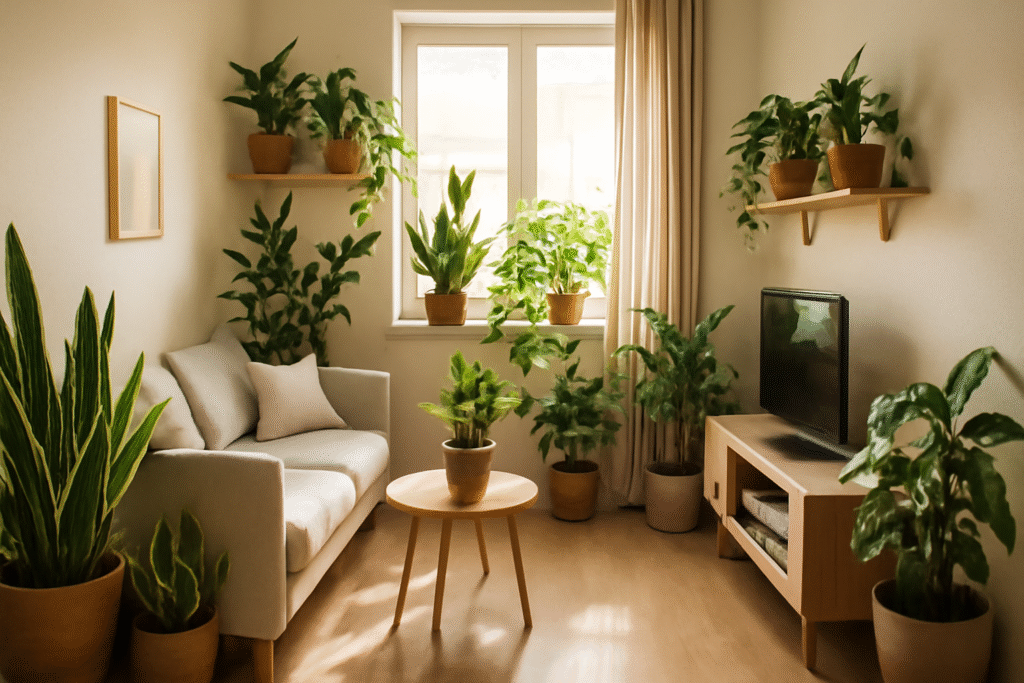
10 Best Indoor Plants for Small Spaces: Easy-to-Care Options for a Greener Home
Are you living in a cozy apartment or small home and craving a touch of nature? 
However, choosing the right plants that thrive in compact spaces and require minimal care can feel overwhelming. With so many options out there, it’s hard to know where to start. This article will introduce you to 10 of the best indoor plants for small spaces—plants that are not only low-maintenance but also add a vibrant touch to your home without taking up too much room.
By the end, you’ll have all the tips and plant recommendations you need to create your own green oasis, no matter how small your space may be. Keep reading, and let’s transform your home into a thriving, nature-filled retreat!
Table of Contents
ToggleWhat to Look for When Choosing Indoor Plants for Small Spaces
When it comes to selecting indoor plants for small spaces, there are a few key factors that will help you choose the right plants for your home. Choosing wisely ensures your plants thrive, even in tight quarters, and it keeps maintenance easy. Here’s what to consider:
1. Size Matters 
One of the first things to think about is size. In a small space, you want plants that won’t take up too much room or overwhelm the area. Look for compact plants or varieties that stay small and won’t outgrow their spot.
Some plants, like the Snake Plant or ZZ Plant, naturally stay small and are perfect for tight corners, shelves, or tabletops.
2. Light Requirements 
Plants are all about the right light. Some need direct sunlight, while others thrive in low-light areas. Assess the natural light in your home and choose plants that match it.
- Low light: Choose plants like the ZZ Plant or Chinese Evergreen for darker areas or rooms with minimal sunlight.
- Bright, indirect light: If your space has plenty of natural light, plants like Pothos or Peace Lilies will flourish.
3. Care Level 
If you’re new to indoor plants or have a busy lifestyle, low-maintenance options are key. Opt for plants that don’t need constant attention. For example, the Snake Plant and Spider Plant are both forgiving if you forget to water them for a few days.
For a more hassle-free plant collection, go for varieties that are tough and adaptable to different environments.
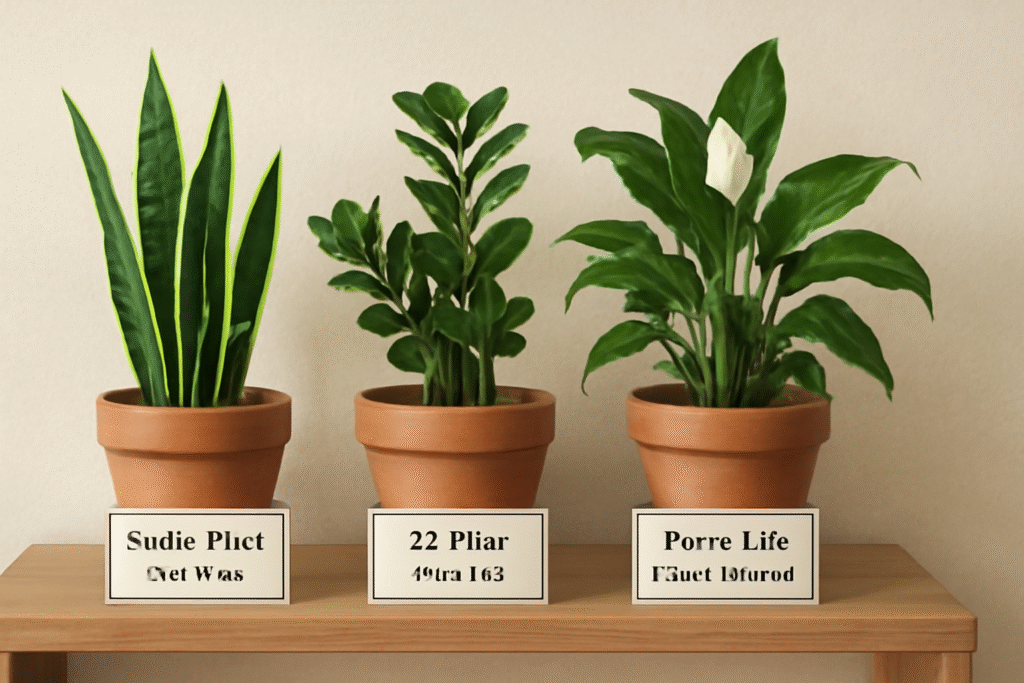
4. Growth Rate 
Some plants grow rapidly, while others are slower. Fast-growing plants, like Pothos, may need frequent pruning, which could be a hassle in small spaces. Slow-growing plants, such as Aloe Vera or Snake Plants, require less maintenance and won’t outgrow their spot too quickly.
5. Humidity and Temperature 
Different plants have different humidity and temperature needs. In small spaces, especially in apartments, humidity levels can fluctuate. Make sure to choose plants that can tolerate the environment in your home.
- Dry air: Plants like Aloe Vera or Cactus thrive in drier conditions.
- Higher humidity: If your home tends to be a bit more humid, Peace Lilies or Calatheas are excellent choices.
6. Space Optimization 
Even in small spaces, you can still find room for your plants! Consider creative ways to display them:
- Hanging planters or shelves can free up valuable floor space.
- Plant stands elevate plants, making them stand out without taking up too much room.
10 Best Indoor Plants for Small Spaces
Finding the perfect indoor plants for small spaces is easier than you might think! To help you create a green oasis in your home, here are 10 of the best plants that are not only compact but also easy to care for. Whether you’re a beginner or a seasoned plant parent, these plants will thrive in your space with minimal effort.
1. Snake Plant (Sansevieria) 
- Why it’s great: The Snake Plant is nearly indestructible. It thrives in low light, tolerates neglect, and needs little water. Perfect for beginners or anyone with a busy lifestyle!
- Size: Grows up to 3-4 feet tall, but stays narrow.
- Care: Water sparingly, and place in low to bright light.
2. ZZ Plant (Zamioculcas zamiifolia) 
- Why it’s great: The ZZ Plant is another low-maintenance beauty. It thrives in low light and can go for weeks without water.
- Size: Compact, growing about 2-3 feet tall.
- Care: It prefers dry conditions and indirect light. Water when the soil is dry.
3. Pothos (Epipremnum aureum) 
- Why it’s great: Pothos is the ideal hanging plant for small spaces. Its trailing vines can drape from shelves, or you can train it to climb walls or trellises.
- Size: Vines can grow up to 10 feet long, but they can be trimmed to keep them manageable.
- Care: Thrives in low to moderate light, and only needs water when the soil is dry.
4. Spider Plant (Chlorophytum comosum) 
- Why it’s great: This classic houseplant is perfect for small spaces. It’s known for its air-purifying abilities and its baby plant “pups” that sprout out of the main plant.
- Size: Grows up to 1-2 feet tall and wide, but the plant can be pruned to maintain size.
- Care: Likes bright, indirect light, and requires regular watering but will tolerate slight neglect.
5. Peace Lily (Spathiphyllum) 
- Why it’s great: Peace Lilies are beautiful and air-purifying, making them perfect for any small space that needs a touch of nature and fresh air.
- Size: Typically 1-3 feet tall, with graceful white flowers.
- Care: Thrives in low to medium light. Keep the soil moist, but not soggy.
6. Aloe Vera 
- Why it’s great: Known for its healing properties, Aloe Vera is easy to care for and doesn’t require frequent watering.
- Size: Grows slowly, staying compact—perfect for windowsills.
- Care: Prefers bright light and should only be watered when the soil is completely dry.
7. English Ivy (Hedera helix) 
- Why it’s great: If you’re looking for a plant that can climb, English Ivy is a great choice. It’s perfect for hanging baskets or training to grow along shelves or walls.
- Size: Vines can grow up to 10 feet, but you can trim them to keep them small.
- Care: Enjoys bright, indirect light and regular watering. Keep the soil moist, but not soggy.
8. Chinese Evergreen (Aglaonema) 
- Why it’s great: Chinese Evergreen is one of the easiest plants to grow, even in low light. It also has striking foliage that adds a pop of color to your space.
- Size: Typically grows 1-2 feet tall.
- Care: Prefers low to medium light and should be watered when the top of the soil feels dry.
9. Lavender 
- Why it’s great: Not only does Lavender smell amazing, but it’s also compact and easy to care for. It’s perfect for a sunny corner or windowsill.
- Size: Grows about 1-2 feet tall.
- Care: Needs plenty of sunlight and well-drained soil. Water sparingly and allow the soil to dry out between waterings.
10. Calathea 
- Why it’s great: Known for its stunning, colorful foliage, the Calathea will bring vibrancy to your small space. It thrives in low light and doesn’t require a lot of attention.
- Size: Grows up to 1-2 feet tall and wide.
- Care: Prefers low to medium light, and the soil should be kept consistently moist, but not soggy.
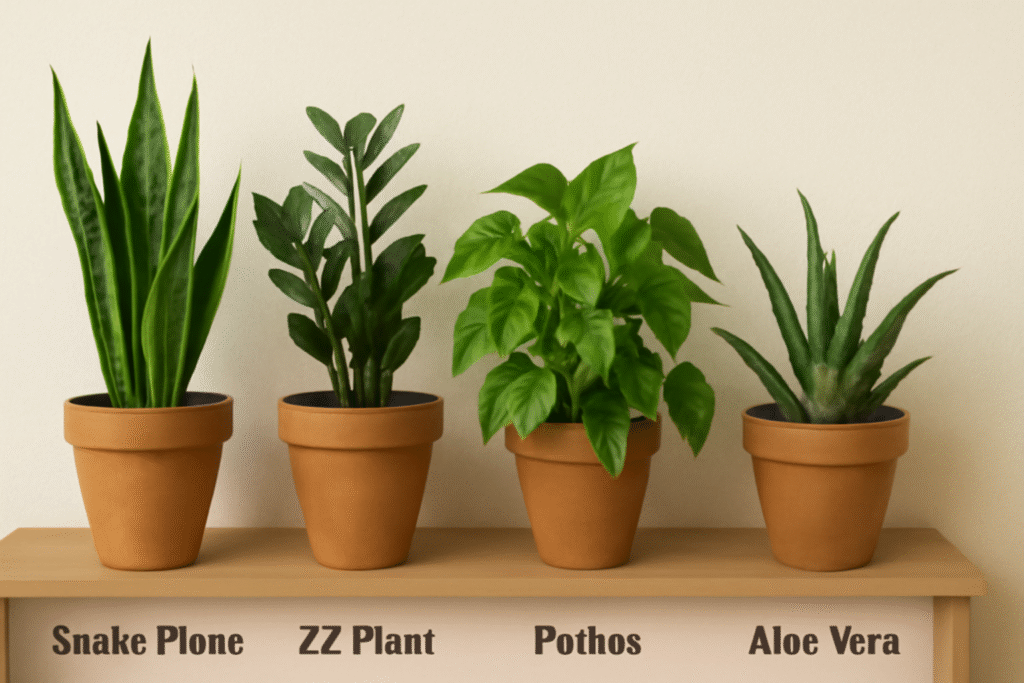
Easy-to-Follow Care Tips for Indoor Plants in Small Spaces
Caring for indoor plants in small spaces doesn’t have to be complicated. By following a few simple tips, you can keep your plants healthy, vibrant, and thriving, even in tight quarters. Whether you’re a beginner or just looking to improve your plant care routine, these practical tips will ensure your plants flourish with minimal effort.
1. Watering Wisely 
Overwatering is a common mistake that can lead to root rot. To avoid this, always check the soil before watering. Stick your finger about an inch into the soil—if it feels dry, it’s time to water. If it’s still moist, wait another day or two.
- Tip: For plants like Aloe Vera or Snake Plants, let the soil dry out completely before watering again.
2. Light, Light, Light 
Make sure your plants are getting the right amount of light. Some plants need direct sunlight, while others thrive in low-light conditions. When placing your plants, consider the direction of your windows:
- Low light: Go for ZZ Plants, Chinese Evergreen, or Snake Plants.
- Bright, indirect light: Pothos, Spider Plants, and Peace Lilies will do best here.
Tip: If natural light is limited, consider using a grow light to supplement.
3. Humidity Control 
Indoor air can often be dry, especially in smaller spaces with little ventilation. Some plants, like the Calathea or Peace Lily, prefer higher humidity. Here’s how to keep them happy:
- Use a humidifier: If you have several plants that thrive in humidity, a small humidifier can do wonders.
- Misting: Lightly mist the leaves of plants that need moisture, but avoid over-wetting them.
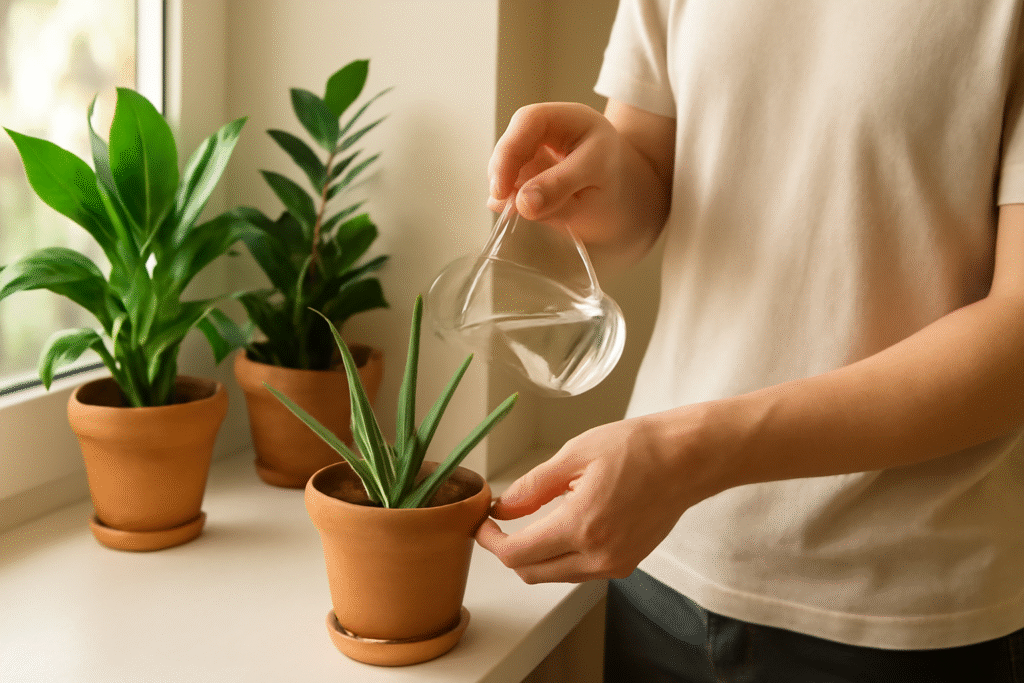
4. Proper Potting & Drainage 
Choose pots with drainage holes to prevent water from collecting at the bottom. Stagnant water can lead to root rot and unhealthy plants. If you love a decorative pot, place a simple plastic pot with drainage inside it.
- Tip: Use well-draining soil to help excess water escape quickly, which is especially important for plants like Aloe Vera.
5. Regular Maintenance 
While indoor plants for small spaces don’t require constant attention, they do need a little TLC from time to time. Here’s what you should do:
- Remove dead leaves: Prune any dead or yellowing leaves to help the plant focus on healthy growth.
- Dust the leaves: Dust can block sunlight, so give your plants a gentle wipe with a damp cloth every few weeks.
6. Rotate Your Plants 
Plants tend tao grow towards the light, so rotating them every couple of weeks ensures they grow evenly and stay balanced. This is especially important for plants like Pothos and Spider Plants, which are often placed on shelves or windowsills.
7. Fertilizing (When Needed) 
During the growing season (typically spring and summer), your plants may benefit from occasional feeding. Use a balanced, water-soluble fertilizer to give them a nutrient boost.
- Tip: Don’t over-fertilize! Once a month is usually enough for most indoor plants.
How to Arrange Indoor Plants in Small Spaces
Arranging indoor plants for small spaces is all about maximizing the space you have while adding beauty and life to your home. With a few smart placement strategies, you can create a lush, green environment that feels spacious and inviting. Here are some tips to help you get the most out of your plants in tight quarters.
1. Use Vertical Space 
When floor space is limited, think up! Vertical planting is a great way to make the most of your small space.
- Wall-mounted shelves: Create a plant wall with floating shelves or brackets. This works well for trailing plants like Pothos or English Ivy.
- Hanging planters: Use ceiling hooks to hang plants like Spider Plants or String of Pearls. This draws the eye upward and adds a touch of greenery without taking up floor space.
2. Cluster Plants Together 
Rather than scattering plants all over the place, group them together in one spot. This creates a mini indoor garden while saving space.
- Tip: Vary the heights and sizes of plants for visual interest. Place taller plants like Snake Plants behind smaller plants such as Aloe Vera or Lavender.
3. Utilize Corners and Window Sills 
Corners are often overlooked, but they’re perfect for adding plants that might otherwise be crowded. Similarly, window sills offer excellent spots for plants that need plenty of natural light.
- Tip: Use corner shelves or plant stands to elevate plants in dark corners. In bright areas, a few plants on the window sill (like Peace Lilies or Calatheas) will thrive.
4. Elevate Plants with Stands 
Plant stands are an excellent solution to maximize space and add style. Use stands to elevate plants off the floor, giving them room to grow while creating a clean, organized look.
- Tip: Choose stands that complement your décor and plant size. Taller stands can highlight a Snake Plant, while shorter stands are perfect for small pots like Aloe Vera or Succulents.
5. Mix Planters and Containers 
Get creative with different types of planters and containers to enhance your plant display. Play with materials like ceramic, terracotta, or woven baskets to add texture and variety.
- Tip: Combine a few statement pots with simpler ones for a balanced, curated look. Just make sure the containers have proper drainage to keep your plants healthy!
6. Think of the Room’s Flow 
Arrange your plants so they don’t block pathways or make the room feel cramped. Place them near seating areas to create a cozy atmosphere without overcrowding the space.
- Tip: Place plants near the edges of the room or on side tables. Keep walkways clear and avoid placing too many plants in high-traffic areas.
7. Rotate for Even Growth 
Plants grow towards the light, so rotating them every couple of weeks ensures they grow evenly and stay balanced. This also helps prevent the plants from becoming lopsided.
- Tip: Keep track of which side of the plant is getting more light and adjust its placement as needed

Common Mistakes to Avoid with Indoor Plants in Small Spaces
When adding indoor plants to small spaces, it’s easy to make some common mistakes that can affect their health and beauty. By being aware of these pitfalls, you can ensure your plants thrive without unnecessary stress. Here are the top mistakes to avoid when caring for your green space.
1. Overcrowding Your Plants 
While it’s tempting to fill every corner with plants, overcrowding can lead to issues like poor air circulation and limited growth space. Plants need room to grow and breathe.
- Tip: Leave enough space between plants to ensure they have access to light and air. Group plants with similar light and water needs together.
2. Ignoring Light Requirements 
One of the biggest mistakes is not matching plants to the light conditions in your space. Some plants thrive in bright, direct sunlight, while others do better in low light.
- Tip: Before buying a plant, assess how much natural light your space receives. Choose low-light plants (like ZZ Plants) for dark areas, and opt for sun-loving plants (like Lavender) for bright spots.
3. Overwatering or Underwatering 
Both overwatering and underwatering can harm your plants. Too much water can lead to root rot, while too little can dry out the plant and cause it to wilt.
- Tip: Check the soil moisture before watering. For most indoor plants, it’s best to wait until the top inch of soil is dry before watering again.
4. Not Using the Right Containers 
Using pots without drainage holes is a common mistake. Without proper drainage, water can get trapped in the pot, leading to root rot and unhealthy plants.
- Tip: Always choose pots with drainage holes, or add a layer of pebbles at the bottom to ensure excess water can escape.
5. Placing Plants in High-Traffic Areas 
In small spaces, it’s easy to place plants in walkways or near doorways, but this can lead to accidents and stress for your plants. High traffic can also expose them to constant movement, which isn’t ideal for their well-being.
- Tip: Keep plants in low-traffic areas, such as corners, shelves, or plant stands, where they won’t be disturbed.
6. Neglecting Regular Maintenance 
While indoor plants don’t need constant care, they still need attention. Neglecting to prune dead leaves, check for pests, or clean dust off the leaves can affect their health and appearance.
- Tip: Set a routine for checking your plants every couple of weeks. Remove dead leaves, wipe the leaves clean, and check for any signs of pests.
7. Not Rotating Plants 
Plants naturally grow toward light, which can cause them to lean or become lopsided. If you don’t rotate them regularly, they might end up growing in an uneven or unnatural direction.
- Tip: Rotate your plants every couple of weeks to ensure even growth and keep them looking their best.
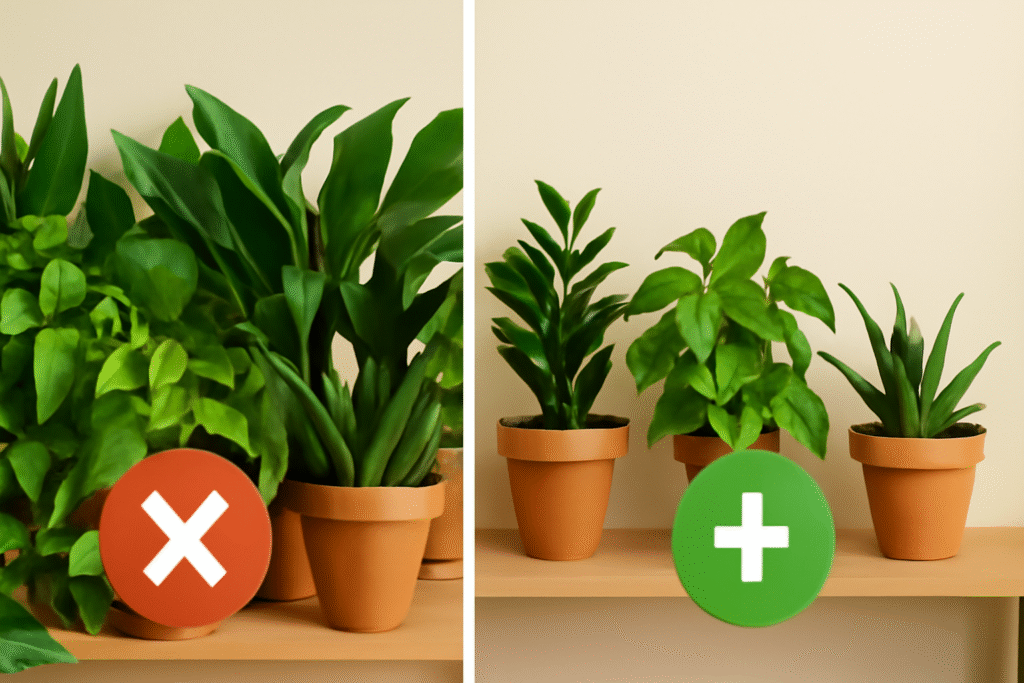
Transforming your small space into a vibrant, green oasis is easier than you think! 
Remember to consider factors like size, light requirements, and care level when selecting your plants. And don’t forget to avoid common mistakes like overcrowding or overwatering. With a little attention and the right plants, your home will soon feel fresher, greener, and more inviting.
Ready to start your indoor garden? Choose a plant from our list and watch it grow—your small space will never feel the same!
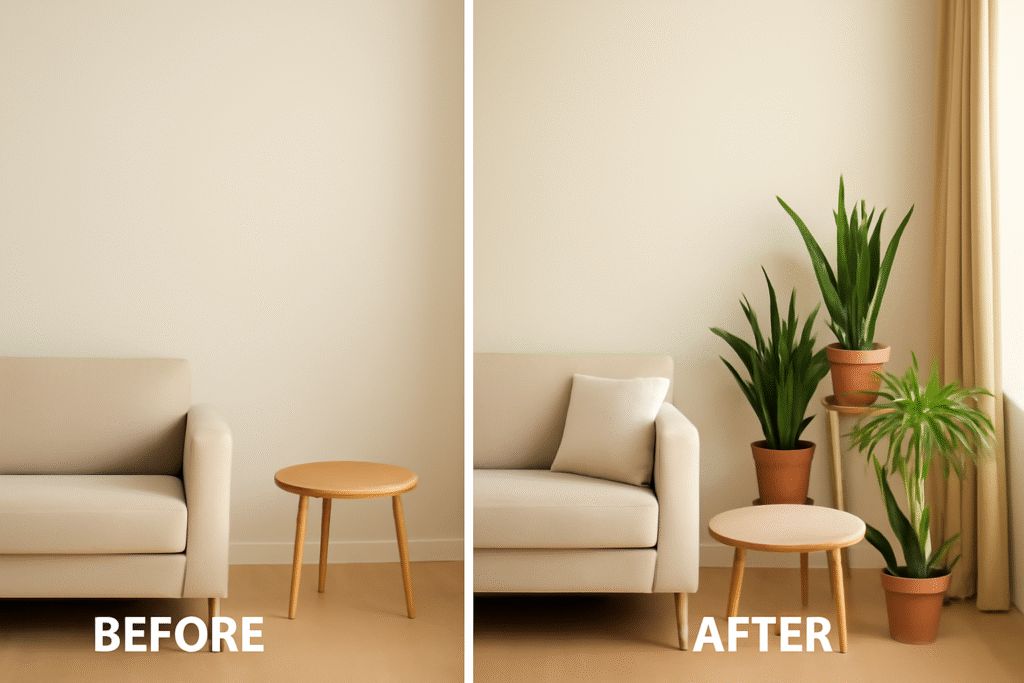
Frequently Asked Questions (FAQ)
1. What are the best indoor plants for small spaces?
The best indoor plants for small spaces are those that don’t take up much room and are easy to care for. Popular options include Snake Plants, ZZ Plants, Pothos, Spider Plants, and Aloe Vera. These plants thrive in small areas, require minimal maintenance, and can adapt to various light conditions.
2. How do I choose the right indoor plants for my apartment?
When choosing plants for your apartment, consider the available light and the amount of space you have. Opt for plants that suit your light conditions, such as Snake Plants for low light or Lavender for bright spots. Also, choose plants that don’t outgrow their space quickly and are easy to maintain.
3. Can I grow indoor plants in a room with no windows?
Yes, some plants can thrive in rooms with little to no natural light. ZZ Plants, Snake Plants, and Chinese Evergreen are excellent choices for low-light spaces. However, if the room is extremely dark, you may want to invest in artificial grow lights to ensure the plants get enough light to survive.
4. How often should I water my indoor plants?
The frequency of watering depends on the type of plant and the environment. As a general rule, water your plants when the top inch of soil feels dry. For low-maintenance plants like Snake Plants or ZZ Plants, you can go longer between waterings, while plants like Peace Lilies may need more frequent watering.
5. Do indoor plants help purify the air?
Yes, many indoor plants are known for their air-purifying qualities. Plants like the Snake Plant, Spider Plant, and Peace Lily can help remove toxins from the air and improve indoor air quality. Having these plants in your home can lead to fresher, healthier air.
6. How can I make my small space feel bigger with indoor plants?
To make a small space feel bigger, use vertical space by hanging plants or placing them on shelves. Group plants together to create a mini indoor garden, and use lightweight, compact plants that don’t overwhelm the room. Keep the area clean and organized to ensure the plants add to the feeling of openness.
7. Are there any indoor plants that are low maintenance?
Yes! Many indoor plants are low-maintenance, including Snake Plants, ZZ Plants, and Aloe Vera. These plants require minimal watering and can adapt to a range of light conditions. They’re perfect for beginners or busy individuals who don’t have time for high-maintenance plants.
8. How do I arrange indoor plants in a small room?
To arrange plants in a small room, consider using vertical planters, hanging baskets, or plant stands to save floor space. Group plants of different heights together to create visual interest, and place them near windows or corners for a natural look. Be mindful not to overcrowd the space and leave room for plants to grow.


